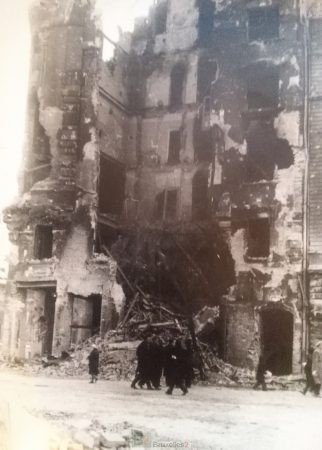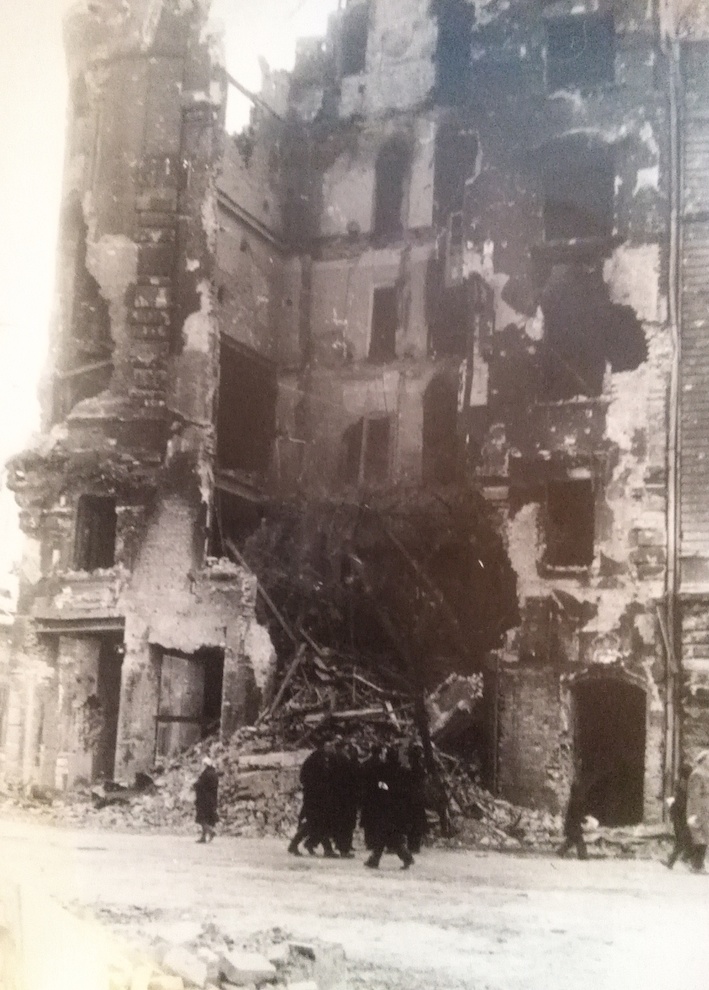60 years ago, the Budapest revolution, a real urban war

(B2) The memory of the revolution has faded... And we forget that what started on October 23, 1956 and lasted just a few weeks until November 4-5 (November 11 for the last battles) in the streets of Pest, Buda and the surrounding area was a real urban battle, probably the last on the European continent before the Yugoslav battles on the horizon of the 1990s (1).
It is not just a few students, workers and intellectuals who are rising up (a real revolution in the Marxist sense of the term). It is indeed a part of the Hungarian police and the Hungarian army (2)(3) which switch in a few hours, a few days, with weapons and luggage on the side of the insurgents. Only the heavily armed political police (AVH) remain in fact loyal to the occupying forces. The first Soviet tanks burst into the Hungarian capital on October 24 at 2 a.m. as the insurgents seized the radio building after fighting. The military movement had been prepared a few days before (4). The first Soviet military intervention is quickly cut short. Defeat seems around the corner. Soviet tanks and troops (5) encounter unexpected resistance. The Molotov cocktail becomes a popular commodity especially as the heavy tanks are difficult to maneuver in the narrow streets. The few cases (rare) of fraternization or reluctance to the intervention of the first troops to intervene - some of which were based in Hungary - raise fears of a certain rout. The troops withdraw (a little)...
An illusory first victory
What then appears as a first victory for the insurgents is in fact mainly due to a cautious military retreat, the time to reconstitute the forces, to bring in reinforcements (safer) in number, and to intervene in a more decisive way. All the political negotiation which will follow can thus appear factitious in fact. The decision of Imre Nagy (the Prime Minister of the revolution) to open political pluralism and to proclaim the neutrality of Hungary will be a point of no return for the Kremlin. But it seems certain that the military decisions were largely anticipated to bring down the power of the insurgents.
Taking control of strategic points
Most of the country's airports (Tököl, Pápa and Veszprém...) are kept or return to Soviet control (this is the case of Budapest-Ferihegy airport on November 3). Officially it is a question of evacuating the wounded, as well as the families of the soldiers and the civilians; nearly 200 aircraft are mobilized in this operation. But above all they provide strategic points for the continuation of the operation and, in passing, allow to freeze any possibility of reaction of the Hungarian air forces.
A ruse of war: rotating the troops
Most withdrawing Soviet tanks do indeed perform a turning move, withdrawing from the Hungarian capital, only to reappear in another location. Reinforcements are called in number, coming from Central Asia in particular, because judged more reliable or less acquired with the Western sensitivity than those stationed in the countries of the bloc. " Public chat the eastern border, after two days (27 and 28 October) of relative immobility, again troop movements were observed mentions the UN report. At Záhony, the border post of Transcarpathia, near present-day Ukraine "at least 100 tanks were located on Hungarian territory, while a force considerablemotorized infantry, with artillery vehicles and Support tank units, moving west towards Nyíregyháza ". The next day, " 133 light tanks and 80 of the latest heavy tank model [T-54] cross the border at Zahony, more than compensating for the few tanks and infantry vehicles [made a contrary move] moving east from Nyíregyháza”.
Safer reinforcements...
The second intervention, on the night of November 3 to 4, is therefore much more substantial. The number of troops engaged is substantial: about 2500 tanks and 1000 other vehicles are in Hungary on November 3. And between 75.000 and 200.000 men are mobilized. The aviation is also mobilized to crush the last centers of revolt (especially around the factories on the outskirts of Budapest: Csepel or Dunapentele). The hesitation of the Hungarian power - understandable to avoid giving arguments to the speakers - allowed the Soviet steamroller to do its work quickly.
European A-reaction
Westerners will not really react except in words. The French and British left to fire at Suez. The Americans are busy stopping them... with the support of the Russians. Moscow has a free rein to put Hungary back on the "right path"... The last call from Radio Kossuth (the national radio station taken over by the insurgents) in English, German and Russian, before being put out of service, will resound in the void.
“This is the Hungarian Writers' Union! We appeal for help to writers, scholars, writers' associations, academies, scientific organizations and the leaders of intellectual life all over the world. Our time is limited! You all know the facts, there is no need to explain them. Help Hungary! Help the Hungarian people! Help the Hungarian writers, scholars, workers, peasants and intellectuals! Help! Help! Help!”
The heavy price paid by the population, the Soviet army badly affected
60 years later, the balance sheet remains unclear. The Soviet army will however pay a price which seems heavy for a few weeks of battles. The commonly accepted toll is 700 dead and several thousand wounded, in the Soviet ranks, in a few days. It would be higher according to the recent report of a Hungarian general officer, without however reaching exaggerated assessments given at the time (6). On the Hungarian side, there is talk of 2500 to 3000 deaths throughout the country (including 1800/2000 for the capital alone) over the two weeks of insurrection. The majority are young people: more than one in five is under 20 years old, more than one in four is between 20 and 39 years old. In all, 13.000 people were treated in Hungarian clinics and hospitals during the events (not counting the minor injuries who were not hospitalized but cared for in mobile nursing stations). If we make a ratio, it therefore gives 1 side armed forces against 3 or 4 side insurgents. Which gives the value of the intensity of the fights and the resistance.
The very intense fighting illustrated by the buildings
Nearly 20.000 apartments were damaged in Budapest, 2200 of which were completely destroyed, or 4,1% of the city's housing stock according to a report drawn up by the city in February 1957 (7). The photo illustrating this article gives an idea of the intensity of the fighting. Between 170.000 and 200.000 Hungarians leave the country in a few days to take refuge in neighboring countries: Austria in the first place or Yugoslavia (8).
(Nicolas Gros-Verheyde)
One can read with profit the report published by the UN one year after the events in 1957, very enlightening, to download here
(1) The events started earlier, notably in Szeged, a student town in the south of the country. Students demonstrating for better living and working conditions, and freedom of expression, in the wake of what happened in Poland.
(2) During the first demonstrations, on October 23, there were 800 military academy cadets in uniform among the demonstrators.
(3) The Hungarian army then comprised nine infantry divisions, two "mechanized" armored divisions, four artillery brigades, a chemical engineering battalion, a cavalry brigade, a signals regiment, a communications brigade and three heavy armored regiments. A total of 250.000 men. The air force has more than 500 aircraft: a combat division composed of three regiments, each composed of 120 aircraft, six simple echelons equivalent to a regiment of 120 aircraft, an air regiment of 50 aircraft and a fighter-bomber regiment with 37 aircraft. The Danube Fleet has two river brigades and the Security Police has several regiments of armed infantry and armored units.
(4) On October 20-21, pontoon bridges were assembled at Záhony on the Hungarian-Soviet border. On October 21 and 22, in regions neighboring Romania, all leave for Soviet officers and Hungarian-speaking reserve officers was abolished. On October 22, movements of forces based in Western Hungary are observed moving towards Budapest.
(5) The Soviets had two divisions stationed in Hungary before the uprising: the 2nd and 17th Armored Divisions, a force of about 20.000 men and 600 tanks. To these were added reinforcements from neighboring Romania, the 32nd and 34th armored divisions based in Timisoara.
(6) Without reaching the figure of 7000 Russians killed and 25.000 Hungarians dead cited by Indian Prime Minister Nehru in December 1956.
(7) An initial report mentioned 40.000 damaged apartments, of which 23.000 seriously and 4000 completely destroyed.
(8) Read: Remember 1956 Viktor Orban! When Europeans were a little more united


